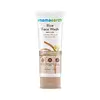Mamaearth Rice Face Wash With Rice Water & Niacinamide Versus Garnier Oil Clear Clay D-Tox Icy Face Wash
What's inside
What's inside
 Key Ingredients
Key Ingredients

 Benefits
Benefits

 Concerns
Concerns

 Ingredients Side-by-side
Ingredients Side-by-side

Myristic Acid
CleansingGlycerin
HumectantWater
Skin ConditioningPotassium Hydroxide
BufferingPropylene Glycol
HumectantStearic Acid
CleansingDecyl Glucoside
CleansingLauric Acid
CleansingGlycol Stearate
EmollientGlyceryl Stearate
EmollientSodium PCA
HumectantPhenoxyethanol
PreservativeRice Ferment Filtrate
Skin ConditioningPolyquaternium-7
Niacinamide
SmoothingTitanium Dioxide
Cosmetic ColorantGlyceryl Glucoside
HumectantTocopherol
AntioxidantBHT
AntioxidantWater
Skin ConditioningSorbitol
HumectantLauric Acid
CleansingStearic Acid
CleansingMyristic Acid
CleansingPotassium Hydroxide
BufferingGlycol Distearate
EmollientPalmitic Acid
EmollientKaolin
AbrasiveSodium Cocoamphoacetate
CleansingCoco-Betaine
CleansingParfum
MaskingCharcoal Powder
AbrasiveSodium Chloride
MaskingHydroxypropyl Methylcellulose
Emulsion StabilisingSodium Benzoate
MaskingSodium Dehydroacetate
PreservativePhenoxyethanol
PreservativePolyquaternium-7
Polyglycerin-10
HumectantPolyglyceryl-10 Myristate
Skin ConditioningPolyglyceryl-10 Stearate
Skin ConditioningCamellia Sinensis Leaf Extract
AntimicrobialMenthol
MaskingDisodium EDTA
Citrus Limon Fruit Extract
MaskingCitric Acid
BufferingDextrin
AbsorbentWater, Sorbitol, Lauric Acid, Stearic Acid, Myristic Acid, Potassium Hydroxide, Glycol Distearate, Palmitic Acid, Kaolin, Sodium Cocoamphoacetate, Coco-Betaine, Parfum, Charcoal Powder, Sodium Chloride, Hydroxypropyl Methylcellulose, Sodium Benzoate, Sodium Dehydroacetate, Phenoxyethanol, Polyquaternium-7, Polyglycerin-10, Polyglyceryl-10 Myristate, Polyglyceryl-10 Stearate, Camellia Sinensis Leaf Extract, Menthol, Disodium EDTA, Citrus Limon Fruit Extract, Citric Acid, Dextrin
Ingredients Explained
These ingredients are found in both products.
Ingredients higher up in an ingredient list are typically present in a larger amount.
Lauric Acid is a fatty acid or lipid. About half of fatty acids in coconut oil is lauric acid.
This ingredient helps hydrate and sooth skin. As a humectant, it helps trap moisture. It also aids in cleaning and enhancing the texture of products.
Lauric acid may not be Malassezia folliculitis, or fungal acne, safe.
Learn more about Lauric AcidMyristic Acid is a saturated fatty acid. It is naturally found in milk fat. Other sources include palm oil, coconut oil, and butter fat.
Myristic Acid is an emulsifer and cleanser. As an emulsifer, it stabilizes a product by preventing ingredients from separating. Myristic Acid helps clean your skin by acting as a surfactant. It tends to gather oil and dirt on your skin to be easily rinsed away.
One study from 2021 found Myristic Acid to have anti-inflammatory properties.
Learn more about Myristic AcidPhenoxyethanol is a preservative that has germicide, antimicrobial, and aromatic properties. Studies show that phenoxyethanol can prevent microbial growth. By itself, it has a scent that is similar to that of a rose.
It's often used in formulations along with Caprylyl Glycol to preserve the shelf life of products.
Polyquaternium-7 is a light to clear colored liquid. It is commonly found in haircare products for its film-forming and anti-static properties.
According to a manufacturer, it is a non-paraben and specially developed for negatively charged surfactant systems. This makes it a great hairstyle holder and helps to improve wet hair detangling without adding buildup.
Potassium hydroxide is commonly known as caustic potash. It is used to fix the pH of a product or as a cleaning agent in soap. In cleansers, it is used for the saponification of oils.
Sapnification is the process of creating fatty acid metal salts from triglycerides and a strong base. During this process, Potassium Hydroxide is used up and is not present in the final product.
Using high concentrations of Potassium Hydroxide have shown to irritate the skin.
Learn more about Potassium HydroxideStearic Acid is a fatty acid. It is an emollient, emulsifier, and texture enhancer.
As an emollient, stearic acid helps soften skin. It aids the skin's protective barrier by preventing water loss. It also provides a gentle cleansing effect without stripping away natural oils.
Stearic acid may also be used to enhance the texture of products. It can add volume and stabilize ingredients such as water and oil. This can help water and oil ingredients from separating.
Sources of stearic acid include animal or vegetable fats/oils such as coconut or shea. It can be naturally found in butter, cocoa butter, shea butter, vegetable fats, and animal tallow.
This ingredient may not be Malassezia folliculitis, or fungal-acne safe.
Learn more about Stearic AcidWater. It's the most common cosmetic ingredient of all. You'll usually see it at the top of ingredient lists, meaning that it makes up the largest part of the product.
So why is it so popular? Water most often acts as a solvent - this means that it helps dissolve other ingredients into the formulation.
You'll also recognize water as that liquid we all need to stay alive. If you see this, drink a glass of water. Stay hydrated!
Learn more about Water